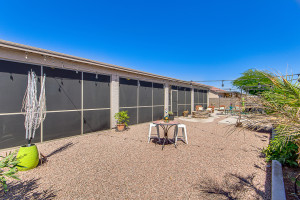
Did you know Pinal County officials want the county to become greener through renewable energy operations to fuel broader economic development? With over 3,000 acres of solar, the ethanol plant in Maricopa and the anaerobic methane digesters at the Stanfield biogas (bio-gas) plant, it appears Pinal County is indeed moving toward it’s goal of being a “green” county. Well, maybe that’s what I’d say if I knew what the heck an anaerobic methane digester is.
I had an informative meeting with Pinal County Supervisor, Stephen Miller today. I walked out with inspiration to look further into reducing emissions of methane from livestock and to write this post.
Anaerobic digestion is a series of biological processes in which microorganisms break down biodegradable material in the absence of oxygen. One of the end products is biogas (bio-gas) which is combusted to generate electricity and heat, or can be processed into renewable natural gas and transportation fuels. An anaerobic digester facilitates the process.
According to www.onegreenplanet.org,“methane, the gas produced extensively by the livestock industry worldwide, traps up to 100 times more heat in the atmosphere than carbon dioxide within a 5 year period, and 72 times more within a 20 year period. The good news is that methane also leaves the atmosphere within a decade. This makes for a short-lived, but intense climate changer.”
So, what do we do about it? According to the Environmental and Energy Study Institute, “Using stored biogas limits the amount of methane released into the atmosphere and reduces dependence on fossil fuels. The reduction of methane emissions derived from tapping all the potential biogas in the United States would be equal to the annual emissions of 800,000 to 11 million passenger vehicles. Based on a waste-to-wheels assessment, compressed natural gas derived from biogas reduces greenhouse gas emissions by up to 91 percent relative to petroleum gasoline. According to the EPA, “From 2000 through 2018, anaerobic digesters on livestock farms have reduced direct and indirect emissions by 39.6 MMTCO2e.” (million metric tons of carbon dioxide equivalents). PLEASE help me find a more relatable conversion and send it to me. I’d rather not share what I think I was able to find because I’m not sure enough.
The biogas, or the methane and CO2 that was produced and emitted into the atmosphere is now being captured in the top of digester tanks at the biogas plant and cleaned up into natural gas. Parts that are not digested are still highly valuable fertilizer that goes back to farmland. Liquid digestate can be easily sprayed as fertilizer, reducing the need for synthetic fertilizers. Located just outside of Stanfield, the methane plant will send the natural gas it captures to Los Angeles. The remaining digestate will be processed into fertilizer at the Stanfield plant. How cool is that?
With companies nationally looking for “greener” locations, Pinal County may just be a prime location for them to land. What more could a manufacturing company ask for? A county assisting and encouraging sustainability plus the added bonus of location for easy transportation.
I live in Pinal County in the city of Casa Grande which is strategically located at the intersection of two major interstates, I-8 and I-10. It’s just 45 minutes south of the Phoenix Airport and an hour north of Tucson. Running through Casa Grande, the Union Pacific Railroad’s mainline is like an interstate to the world as it runs goods that get shipped to Asia. All of which is an economic developer’s dream.
I’ve tried to learn as much as I can about “green” features as I hear more about them. In 2017, I was the first realtor in Pinal County to get my “GREEN” designation. It’s now 2023 and I am still the only realtor here with the designation. I get excited to hear about environmentally friendly solutions, failures we can learn from and I love to promote successful green alternatives where I can. Please let me know about any environmentally friendly ideas or experiences you have.



















